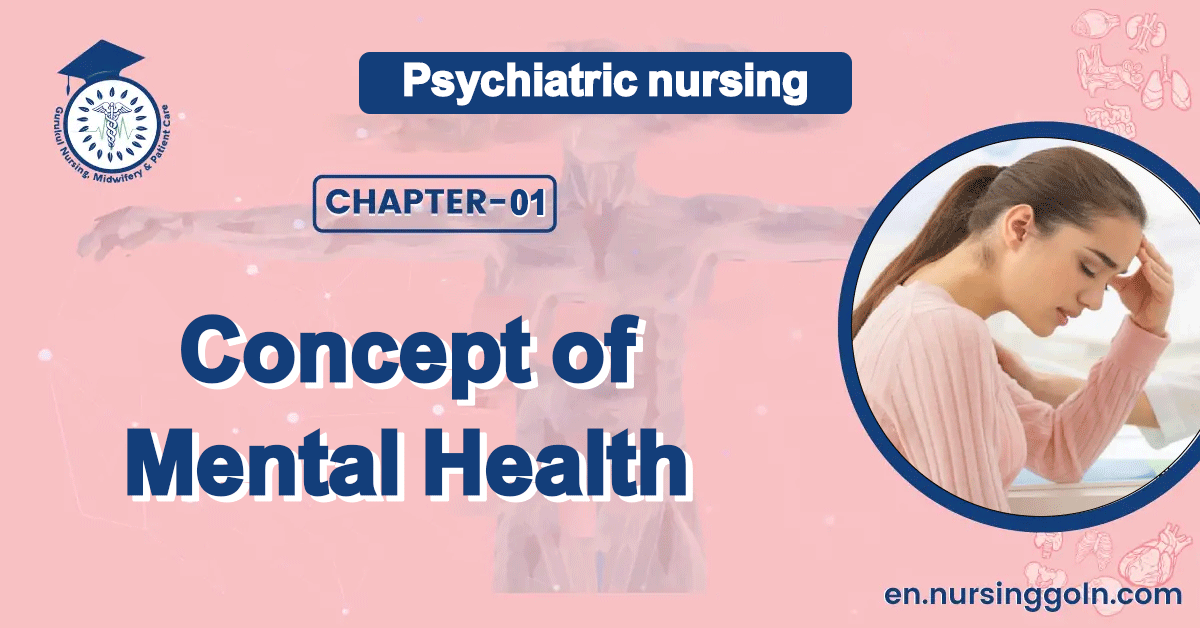Concept of Mental Health – This book covers the entire syllabus of “Psychiatric Nursing” prescribed by the Universities of Bangladesh- for Basic and diploma nursing students. We tried to accommodate the latest information and topics. This book is an examination-friendly setup according to the teachers’ lectures and examination questions.
At the end of the book previous university questions are given. We hope in touch with the book students’ knowledge will be upgraded and flourish. The unique way of presentation may make your reading of the book a pleasurable experience.

Concept of Mental Health
‘People who fail to fulfill their roles and carryout responsibilities or whose behaviour is inappropriate to the situation are viewed as, ‘Mental Illness’.
[Ref: KP Neeraja/P/Vol-1/72]
Or,
Mental illnesses are health conditions involving changes in thinking, emotion or behavior (or a combination of these). Mental illnesses are associated with distress and/or problems functioning in social, work or family activities.
Or,
‘A clinically significant behavioral or psychological syndrome or pattern that occurs in an individual and associated with distress or disability or significantly increased risk of pain, disability, lack of freedom and death’.
Or,
[Ref: American Psychiatric Association, 2000]
Or,
A mental illness is a disease that causes mild to severe disturbances in thought and/or behavior, resulting in an inability to cope with life’s ordinary demands and routines.
Characteristic of mental illness
Characteristics of mental illness:
1. When a person’s behavior is causing distress and suffering to the individual and/or others around him.
2. Abnormal changes in one’s thinking, feeling, memory perceptions and judgment resulting in changes in talk and behavior.
3. Abnormal behavior causes disturbance in the person’s day-to-day activities, job and in interpersonal relationships.
4. All the above may be considered as characteristics of mental illness. As somebody put it, “a person who is either sad or bad or odd can be considered abnormal, if these qualities cause problems to him and to others’.
[Ref: S Namb/2/33/]
Or (another answer)
✔ Worrying all the while.
✔ Inability to concentrate.
✔ Continually unhappy.
✔ Loses temper easily.
✔ Regular sleep disturbance.
✔ Incapacitating fluctuations of mood.
✔ Continual disliking of people’s company.
✔ Easily upset by disturbed daily routine.
✔ Having constant pain and aches without physical cause.
✔ Fear and panic without real cause.
✔ Feeling own decisions always right and other’s wrong.
[Ref: RKH/5/425]

Or (another answer)
In Adults, Young Adults and Adolescents:
- Confused thinking
- Prolonged depression (sadness or irritability)
- Feelings of extreme highs and lows
- Excessive fears, worries and anxieties
- Social withdrawal
- Dramatic changes in eating or sleeping habits
- Strong feelings of anger
- Strange thoughts (delusions)
- Seeing or hearing things that aren’t there (hallucinations)
- Growing inability to cope with daily problems and activities
- Suicidal thoughts
- Numerous unexplained physical ailments
- Substance use
In Older Children and Pre-Adolescents:
- Substance use
- Inability to cope with problems and daily activities
- Changes in sleeping and/or eating habits
- Excessive complaints of physical ailments
- Changes in ability to manage responsibilities – at home and/or at school
- Defiance of authority, truancy, theft, and/or vandalism
- Intense fear
- Prolonged negative mood, often accompanied by poor appetite or thoughts of death
- Frequent outbursts of anger
In Younger Children:
- Changes in school performance
- Poor grades despite strong efforts
- Changes in sleeping and/or eating habits
- Excessive worry or anxiety (i.e. refusing to go to bed or school)
- Hyperactivity
- Persistent nightmares
- Persistent disobedience or aggression
- Frequent temper tantrums.
High-risk groups for mental illness
High risk Groups:
Some people appear to be especially vulnerable to mental illness because of their hereditary background or surroundings.
Following factors are responsible for the genesis of mental illness:
- Large, low income families
- Unemployment
- Lack of close friend or confident
- Single parent families
- Prolonged serious illness
- Drug dependence.
Classification of mental illness
Classification of psychiatric illness:
1. Organic mental disorders:
➤ Delirium (Acute organic mental disorder)
➤ Dementia (Chronic organic mental disorder)
2. Functional (non-organic) mental disorders:
A. Psychotic disorders
➤ Schizophrenia
➤ Mood (affective) disorder
➤ Delusional (paranoid) disorder
B. Neurotic disorders
➤ Anxiety disorders (Generalized anxiety disorder, panic disorder and phobic disorder)
➤ Obsessive compulsive disorder.
➤ Personality disorders.
3. Psychosexual disorders.
4. Personality disorder.
5. Stress-related disorders:
➤ Acute stress reaction
➤ Post-traumatic stress disorder
➤ Adjustment disorder.
6. Mental disorders due to psychoactive substance abuse:
➤ Alcohol dependence
➤ Other drugs dependence
7. Somatoform disorders.
8. Dissociative (Conversion disorder):
➤ Hysteria
➤ Hypochondriasis
➤ Somatization disorder.
9. Psychosomatic (psychophysiological) disorders.
10. Child psychiatric disorders:
➤ Autism
➤ Developmental disorders
➤ Mental retardation
➤ Attention deficit disorders
➤ Conduct disorders
11. Other disorders:
➤ Eating disorders.
➤ Disorders of sleep.
➤ Disorders of memory.
➤ Epilepsy and psychiatric aspects
➤ Psychiatric disturbances in women
➤ Psychiatric disturbances in adolescence
➤ Psychiatric disturbances in old age.
[Ref: S Nambi/24/44-45]

Classification of mental disorder according to ICD 10:
1. FO: Organic mental disorders.
2. F1: Disorders due to psychoactive substance misuse.
3. F2: Schizophrenia, schizotypal and delusional disorders.
4. F3: Mood disorders.
5. F4: Neurotic, stress related and somatoform disorders.
6. F5: Behavioural syndromes associated with psychological disturbances.
7. F6: Disorders of adult personality disorder and behaviour.
8. F7: Mental retardation.
9. F8: Disorders of psychological development.
10. F9: Behavioural and emotional disorders with onset usually occurring in childhood and adolescence.
Diagnose mental illness
Criteria to diagnose mental illness:
1. Dissatisfaction with one’s own characteristics, abilities and accomplishments
2. Ineffective or unsatisfying relationships
3. Dissatisfaction with one’s place in the world
4. Ineffective coping with life events
5. Lack of personal growth.

Model to distinguish abnormal mental health
Models to distinguish between normal and abnormal mental health:
1. Statistical model: The behavior that most people display is considered normal; and behavior that deviates from that of the majority is considered abnormal
2. Medical model: Abnormal behavior is ‘disease like and can be diagnosed and treated.
3. Behavior model: Maladaptive Behavior is abnormal. Abnormal behavior is a set of a faulty behavior through learning.
4. Personal distress model: A behavior which is going to produce distress or discomfort to the individual and at times to others is considered to be abnormal.
5. Legal model: A person’s behavior, when he is not able to judge that what he is doing is right or wrong, is abnormal.
Difference between mental health and mental illness
| Mental health | Mental illness |
Individual feels comfortable about himself. | Mentally ill patients are unstable and unreliable. |
Able to maintain personality | Unable to maintain personality |
Mentally healthy person are able to meet the demand of life | Cannot meet the demand of life |
Able to adopt self to the society | Unable to adopt self to the society |
Mentally health person’s make necessary adjustment. | Cannot make adjustment |
Health and mind is well | Health and mind is not well |
Able to distinguish between right & wrong. | Unable to distinguish between right & wrong. |
[Ref: www.wikipedia.org/]
Read more:
